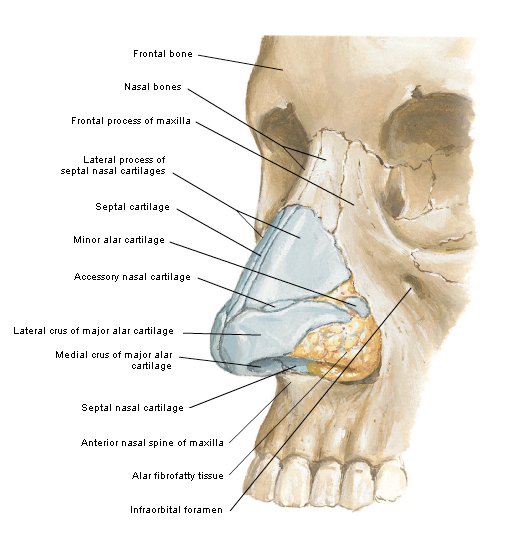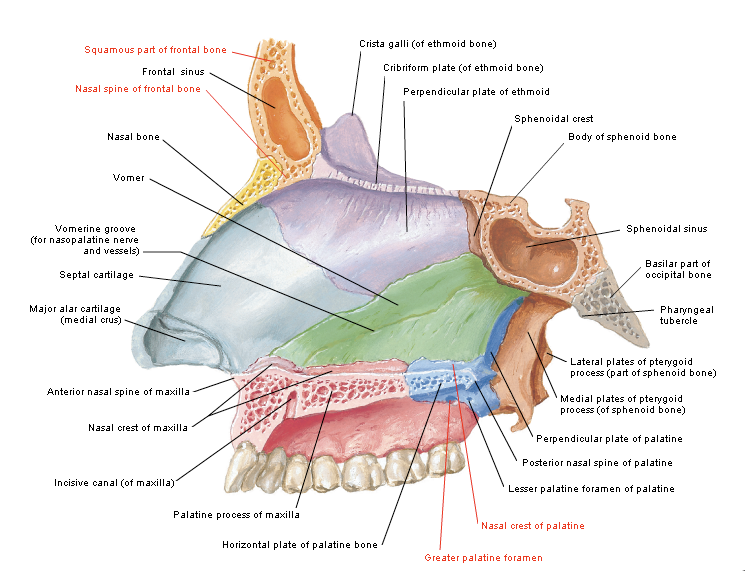The skeletal component of the nose includes the frontal process of the maxilla, the nasal process of the frontal bone, the ethmoid, the vomer, and the nasal bones. Fractures of the nasal bones occur more commonly distally, where they are broader and thinner. Significant force is required to fracture the more proximal nasal bones, in which case injury extension into the frontal process of the maxilla and frontal bone may be present.
The cartilaginous structures include the two lower lateral cartilages, two upper lateral cartilages, and the central septal cartilage. Paired upper lateral cartilages have solid attachments to the caudal aspect of the nasal bones and help maintain the midline location of the quadrangular cartilage. The lower lateral cartilages provide little midline
structural support but are responsible for much of the aesthetics and contour of the nasal tip. The fact that cartilage surrounds the bony matrix both dorsally and laterally to provide a soft and malleable framework allows some dissipation of force without incurring a permanent deformity. In general, significant force is required for a cartilaginous
injury.

skip to main |
skip to sidebar
Daily, Monthly, Yearly
The longest journey begins with the first step,
Step by Step.
Search
Follow
RECENT POST
Labels
- Adrenal insufficiency (1)
- airway obstruction (1)
- alveoli (1)
- Ameloblastoma (1)
- antibiotic (1)
- antibiotic prophylaxis (1)
- anticoagulant (1)
- antiplatelet (2)
- ASA (1)
- autoregulation (1)
- Bilateral sagittal split osteotomy (1)
- bilirubin (1)
- biopsy (1)
- Bisphosphonate induce osteonecrosis (1)
- book (1)
- Brain injury (1)
- Brown sequard syndrome (1)
- BSSO (1)
- CA metastasis node (1)
- Calcium channel blocker (1)
- cancer (1)
- CBF (1)
- Chronic renal failure (1)
- Cocaine (1)
- conjugated (1)
- Coronectomy (1)
- COX-1 (1)
- COX-2 (1)
- danzen (1)
- deep temporlais fascia (1)
- dental consideration (4)
- dental extraction (1)
- diabetes mellitus drug (3)
- diabtes ketoacidosis (1)
- DM drug (1)
- dual antiplatelet (1)
- erytholeukoplakia (1)
- erythoplakia (1)
- Erythropoietin (1)
- Etomidate (1)
- extraction (1)
- facial fracture (3)
- facial nerve (1)
- Fibrous dysplasia (1)
- fracture mandible (1)
- Frontal sinus (1)
- Giant cell tumor of the jaw (1)
- HBO (1)
- Hemangioma (1)
- Hemostatic agent (1)
- HPA (1)
- Hypertension (1)
- Hyperventilation (1)
- Hypoventilation (1)
- IHD (1)
- impaction (1)
- IV anesthetic agent (1)
- Ketamine (1)
- lacrimal canaliculi injury (1)
- lateral pterygoid muscle (1)
- lefort I osteotomy (1)
- left shift (1)
- leukoplakia (1)
- liver disease (1)
- Local anesthesia (1)
- localized (1)
- lung (1)
- madibular fracture (3)
- MAP (1)
- maxillary fracture (2)
- Maxillary sinus (1)
- Melanin (1)
- Melanin stimulating hormone (1)
- Melanocyte (1)
- Monoclonal antibody (1)
- multiple myeloma (1)
- nasal bone fracture (3)
- nerve injury (2)
- NSAID (1)
- oculocardiac reflex (1)
- oral and maxillo facial surgery (1)
- oral and maxillofacial sugery book (2)
- oral lesion (1)
- Ossifying fibroma (1)
- osteoradionecrosis (3)
- Oxygen affinity (1)
- oxygen dissociation curve (1)
- Peterson (1)
- pigmented (1)
- Plate system (1)
- plavix (1)
- Propofol (1)
- Radiograph (1)
- red lesion (1)
- Regular insulin (1)
- Right shift (1)
- seconary parathyroidism (1)
- serratiopeptidase (1)
- SLOB (1)
- Steroid (2)
- Stroke (1)
- superficial temporalis fascia (1)
- suture (1)
- tear lacrimal canaliculi (1)
- temporalis fascia (1)
- temporopariental fascia (1)
- Thiopental (1)
- Third molar (1)
- toot extraction (1)
- unconjugated (1)
- Vascular malformation (1)
- vasovagal syncope (1)
- ventilation (1)
- white lesion (1)
- x-ray (2)
- ฺsinusitis (1)
Post history
-
▼
2009
(27)
-
▼
February
(12)
- oculocardiac reflex
- Lefort I osteotomy video clip
- fracture mandible and airway obstruction
- ANATOMIC CONSIDERATIONS IN NASAL BONE FRACTURE PAR...
- ANATOMIC CONSIDERATIONS IN NASAL BONE FRACTURE PAR...
- temporal branch of facial nerve injury (danger zone)
- x-ray and fracture line part 2
- x-ray and fracture line
- What is osteoradionecrosis (ORN) ?
- Stage of Osteoradionecrosis -- ORN
- Tear lacrimal canaliculi injury
- CA node metastasis or not
-
▼
February
(12)
3 comments:
Kalyan Hospital is known to be one of the best Ortho Centre in India which is famous for its patient satisfaction record.
Dr. Shailendra Patil's bone and joint care center is the best orthopedic clinic in Kalyan, Vikhroli. Patient satisfying hospital and prfessional staff also their.
Nice blog, I will keep visiting this blog very often. nasal probiotics
Post a Comment